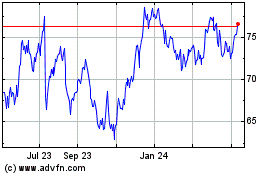Are Banks a "Buy" After Stress Tests? - Real Time Insight
March 14 2012 - 10:41AM
Zacks
The Federal Reserve released the results of the latest round of
stress tests yesterday. 15 out of 19 banks tested passed the test,
paving the way for the strong banks to announce hike in dividends
and buy-back of shares.
Stress tests formally referred to as the Comprehensive Capital
Assessment and Review are basically used by the supervisory
authorities to determine whether the institutions had sufficient
capital to withstand worse than expected downturn in the economic
conditions.
The latest stress tests were “more stressful” than the earlier
ones. The hypothetical stress scenario assumed the unemployment
rate peaking at over 13%, US equity prices falling by 50% and US
housing prices falling by moiré than 20%, in addition to economic
slowdown in Europe and Asia.
Even before the results came in, JPMorgan announced that it
would raise its quarterly dividend by 5 cents, and buy back $15
billion of its stock through 2013. That probably forced the Fed to
announce the results two days ahead of schedule.
Stress tests clearly show that some banks are in a better
financial position now and will most likely to increase their
market share. Banks like JPMorgan (JPM), Wells Fargo (WFC), BNY
Mellon (BK), State Street Corporation (STT) US Bancorp (USB), and
American Express (AXP) posted strong results, while Ally Financial,
the former GMAC bank was the worst performing one, being the only
one to fall short of minimum capital requirements without any
capital plans. Citi (C) and SunTrust Bank (STI) and Met Financial
(MET) had met the minimum capital requirements, but their capital
plans were rejected by the Fed.
US banks have certainly come a long way since the crisis. They
are much better capitalized with more sound risk management
systems. Also, as US economy is on the slow improvement path, while
Euro region is still struggling, the US banks are in a much better
shape than their European counterparts. But some of the big ones
are exposed to their European counterparts.
Also, higher regulatory costs and ultra-low interest environment
will continue to hurt the profitability in near future. And banks
still have a lot of risky mortgages on their balance sheets.
The Financial Select Sector ETF (XLF), which tracks broader
group of financial stocks rallied 4% after the results but is
struggling to maintain that level today. Overall this ETF has
returned more than 18% year-to-date as the investors returned to
take advantage of attractive valuation after the steep sell-off
last year (negative 17% return).
Do you think that the banks have further room to run this
year?
AMER EXPRESS CO (AXP): Free Stock Analysis Report
BANK OF NY MELL (BK): Free Stock Analysis Report
CITIGROUP INC (C): Free Stock Analysis Report
JPMORGAN CHASE (JPM): Free Stock Analysis Report
METLIFE INC (MET): Free Stock Analysis Report
SUNTRUST BKS (STI): Free Stock Analysis Report
STATE ST CORP (STT): Free Stock Analysis Report
US BANCORP (USB): Free Stock Analysis Report
WELLS FARGO-NEW (WFC): Free Stock Analysis Report
To read this article on Zacks.com click here.
Zacks Investment Research
State Street (NYSE:STT)
Historical Stock Chart
From Oct 2024 to Nov 2024

State Street (NYSE:STT)
Historical Stock Chart
From Nov 2023 to Nov 2024
